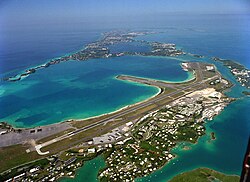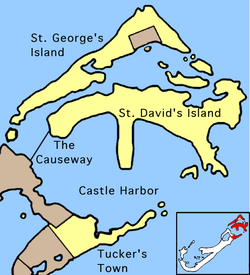Kindley Air Force Base
| Kindley Air Force Base | |||||||
|---|---|---|---|---|---|---|---|
| St. David's Island, Bermuda Near St. George's, Bermuda in United States | |||||||
 The former AFB Kindley Field, as it appeared in 1993 | |||||||
 St. David's Island, after the construction of the airfield. The airfield encompasses all of the Island. | |||||||
| Coordinates | 32°21′52.3″N 64°40′53.5″W / 32.364528°N 64.681528°W | ||||||
| Type | Air force base | ||||||
| Site information | |||||||
| Owner |
| ||||||
| Operator |
| ||||||
| Open to the public | Yes | ||||||
| Condition | Operational - returned to the Bermudian government for use as AMSL | ||||||
| |||||||

Kindley Air Force Base was a United States Air Force base in Bermuda from 1948–1970, having been operated from 1943 to 1948 by the United States Army Air Forces as Kindley Field.
History

World War II
Prior to American entry into the
As the
The airfield was intended to be a joint
There were two air stations operating in Bermuda at the start of the Second World War, the civil airport on
The US Army levelled Longbird Island, and smaller islands at the north of Castle Harbour, infilling waterways and part of the harbour to make a land-mass contiguous with
Postwar use
The US Army was left as the only military establishment on the base after both RAF establishments (at Kindley Field and Darrell's Island) were withdrawn at the end of the war (followed by the closure of most of the Royal Naval Dockyard and withdrawal of the last regular British Army unit in the 1950s), although the RAF (and the Royal Navy Fleet Air Arm) has continued to use its end of the field, converted to a Civil Aviation Terminal by the Civil Aviation department of the Bermuda Government (headed by wartime RAF commander Wing Commander Mo Ware), as a staging post for trans-Atlantic flights.
The
In 1947, it was decided to separate the




During the
At the same time, the U.S. Navy was still operating anti-submarine air patrols with
During the latter stages of the
The previous NAS Bermuda was renamed the NAS Annex and served primarily as a dock area for visiting U.S. naval vessels and as a support facility for the nearby Naval Facility (NAVFAC) Bermuda that supported the
Since 1962, several sounding rockets were launched from Kindley and the
See also
- United States Army Bermuda Garrison
- Fort Bell Army Airfield(1941–1948)
- Naval Air Station Bermuda, Kindley Field (1970–1995)
- USCG Air Station Bermuda (1963–1965)
- Royal Air Force, Bermuda, 1939-1945

